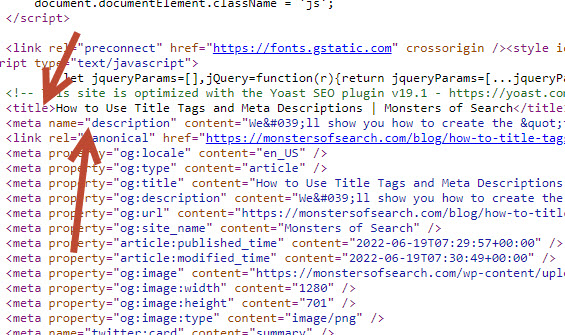How to Use Title Tags and Meta Descriptions
We’ll show you how to create the “front window” of your store, the title and meta descriptions tags, so that customers can find you in search engines.

What Are Title Tags and Meta Descriptions?
You may be wondering what title tags and meta descriptions are. Well, let’s find out!
Title Tags: Title tags are the text that appears in the search results for your website. They’re visible under your site name, which shows up in bold when someone searches for it on Google or any other major search engine. For example, if you were to search for “Healthy Eats” on Google and see my site show up in the results, my title tag would say “Healthy Eats: How to Eat Healthy.”
Meta Descriptions: Meta descriptions are the text that appears below your title tag when someone searches for you online. They help potential customers understand what they’ll get from visiting your website before they even click through to it (or not). They also play a big role in SEO because they tell Google what keywords your page is targeting (more on this later!).
Why Are Title Tags and Meta Descriptions Important?

The title tag and meta description are significant because they’re the first things people will see when they search for you. They’re also the first thing that people read about your business, so it makes sense that you want them to be as effective as possible.
For example, imagine you have a website for an auto repair shop. You’ve been working hard on making sure that no one can fix cars like yours, but when someone searches “best auto repair shop” in Google, what do they see? The results are all over the place: some sites have great content but terrible descriptions; others have good descriptions but poor content; still more sites have neither great content nor great descriptions! In this case, even if someone finds your site through a long-tail keyword like “best car repair shop near me,” they may not click through due to lack of trust or credibility—and then where are they? Back at square one with no idea which car shops might actually be worth visiting (if any).
Title Tag Guidelines
The title tag is the first thing that searchers see when they use Google to search for a specific topic. The purpose of your title tag is to entice people to click on your site and learn more about what you have to offer. So, what should you keep in mind when creating a good title tag?
- It should be short. Ideally, it should be no longer than 60 characters (including spaces). Longer titles will be truncated by Google, which means that some visitors won’t see all of the important keywords in your title. If your website has multiple pages with different content on them (e.g., “How To Do A Pushup,” “How Many Calories Does A Pushup Burn?”), then you’ll need separate pages with unique titles because only one page can rank high in search results at once (you can choose which page ranks highest).
- It should describe what the page contains so that people know if they’re interested before clicking through to read more about it online or going into detail about what each word means within context of its corresponding article/blog.
Meta Description Guidelines
Meta descriptions are a short summary of your page, written in plain language. A good description is between 70 to 160 characters long and provides enough information for readers to decide whether they want to click on the link.
You shouldn’t try to rank better with meta descriptions—instead, they should be useful and relevant to human readers. These are the things that you want people who see search results to read in order to entice them into visiting your site instead of another one:
- Use keywords if appropriate and make sure they are relevant—for example, “Learn how dogs can help you live longer!” rather than “Dogs rule!”
- Avoid unnecessary words like “the” or other common words like “a” and “an”. If these are necessary for clarity or understanding, use them sparingly so that it doesn’t sound clunky when spoken aloud (i.e., don’t write “The dog is at home.”). Some SEO experts say that using long tail keywords like this can help improve rankings because Google rewards content based upon relevancy rather than exact match keywords alone; however there is much debate around this topic so test what works best for your business before making any changes!
Title tags and meta descriptions are like the front window of your store.
Title tags and meta descriptions are like the front window of your store. They’re what customers see first when they begin to explore your site, and they give them an idea of what you’re selling. If a customer sees something interesting in your title tag or meta description, they’ll click through to learn more.
If someone lands on a page with an unappealing title tag or meta description, though, it can make them want to leave the site immediately—even if it’s actually relevant! A poorly formatted title tag or meta description can turn off potential customers who might otherwise have stayed for longer than just one quick glance at your product pages (or even purchased something).
By understanding the value of each element in your title tag and meta description, you can start to implement them in a way that makes sense for your business. At the end of the day, there are no rules or guidelines to follow when it comes to these two elements. You just want to make sure that your audience finds what they need on your page so that Google will reward you with higher rankings on search engines like Google and Bing